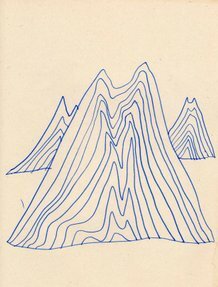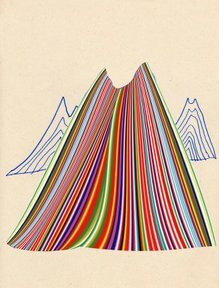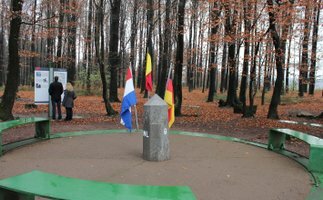The Idea


Vulcanoes as Symbol for a political, social utopia:
Valeska Peschke has spent years on researching the volcano. The subject of volcanoes is a very global one. It deals with the development of the Earth, the explanation of the Earth’s inside and its cosmic cohesion. The volcano is a symbol of transformation and an utopian idea about Europe; the crater is seen as a mouth, which speaks about the inner, global relations and continents, beginning from the melted interior of the Earth. It is for Valeska a beautiful symbol of cohesion of the globe: it shows a sphere with a fiery core: the volcanoes on the surface are connected via sub-surface channels with the glowing core. This force was fascinating her, coming from one central point of the Earth. This is an increasing force that is suddenly covering everything, thereby destroying a lot and at the same time it develops something flourishing and fertile. The volcano is male as also female. In a sculptural process the different elements of the volcano are layering and hence building a symbol of force, power (male) on the one hand and malleability, fertility (female) on the other. This vivid and circular process leads to a renewal, which accrued out of itself. The moment of this eruption or outbreak that eventually leads into a renewal can be compared with the moment of “Instant”. It is that space in-between of cause and the following transformation. This moment of outbreak or that space in-between is intellectually influenceable, malleable and a space in which something is happening. The volcano is for Valeska Peschke a sculptural emblem of change and conversion. Europe has to be seen as a volcano, as an interaction between different continental plates and its cultures above. Chaos, uncertainty and a certain level of hardness, dirt and roughness are essential parts for art and creativity. Historically we can see this picture also at the turn of the century from the 19th to the 20th century. Endless new buildings sprang up energetically, art created groundbreaking results and literature showed the ambivalence between the euphoria of the thriving economy and the insecurity of the people because everything changed all at once. It was also the time of the “Gründerzeit” or Wilhelmine era, which can be compared with so-called Start-ups nowadays. Moreover, the fall of the Berlin Wall 1989 after the Cold War was a moment of eruption, when thousands of people were entering a new area, full of possibilities and chances. It was not only a reunification, but a fundamental change in thinking. Like the volcano is erupting over and over again in order to stay vivid, also society has to experience outbreaks and rebuild itself to keep humanity lively. We cannot focus on stagnation after the transformation, believing the feeling of the renewal will simply continue, thus we cannot freeze intellectually. The fertile ash fall has to bear fruits.
As an artist, Valeska Peschke concentrates on visualising society’s happenings in a creative way. Large-scale installations such as „Aschewolke“ (ash cloud), „First World Catastrophy Camp“ and „Vulkane in Berlin“ (volcanoes in Berlin) are implementing Peschke’s long-time and global art project. As a “volcano researcher” she was guiding tour groups through cities, pointing visible ways in urban space.
Valeska Peschke, Ash cloud, Mural, 710 x 320 cm, Acryl, Galerie Axel Obiger, Berlin, 2014
Crossing boarders to create new space:
My space is the idea I go through like being on a trip. My work deals with traveling environments and environments in transformation: For me the city consists of places where flows of thought, time
and material can be experienced. I develop conceptional worlds and instructions for actions that offer the possibility to experience these or to enter them. The objects are ‘room detectors’ for space in transition. I am observing how the model worlds behave towards the specific site, how they develop into prototypes of objects or buildings, cartographic and topological examinations. A trip begins through these spaces whereby traveler and model can change continuously. I called this process „work of a volcano“.
For Peschke, a process, an opening space, maybe caused by a powerful and even destroying eruption, can never be called a crisis. There are no crises along with threats (e.g. financial crisis, refugee crisis), but rather encompassing changes take place that allow continuous movement. Humans feel under threat, if their familiar surrounding and protected environment is endangered. However, it is not about returning to a “normal situation” or to just eliminate the threat. It is much more about turning the threat into new, creative ideas, a fruitful ground on which something new can emerge. This idea can be compared with the theory of C. G. Jung and Campbell about the archetype of a hero, who has to enter a new world in order to save his homeland. During his/her adventure he/she has to meet challenges to finally reach the progressive moment of knowledge and recognition. By this experience a transformation, conversion or fundamental reform of the previous has been achieved.

Europe and her boarders:
The area which was left neutral by Prussia and the Netherlands was marked almost entirely through arbitrary drawn boundaries. “My home, that are the borders” says it on the plate standing on the spot where Belgian, Germany and the Netherlands meet. But what does the word “boundaries” even mean and how do they come into existence? Not only do borders enclose, they also exclude. They create visible differences and initiate inclusion as also exclusion. Everything that is excluded seems opaque, in other words foreign, alien and maybe even hostile. Nonetheless, borders are not naturally foreign; they are in fact essential for human knowledge. Only by differentiating realms from each other they start to define themselves and gain meaning. However, there still is the issue of inaccurate definition, whereas the problem is not so much the line drawn itself but rather how it was drawn and how the line looks like. Was the border drawn randomly or usefully and necessarily? Peschke wants to make aware of those randomly, unnecessarily drawn borderlines. Her intention is directed to disintegrate them and emphasize on the organically and anthropologically grown regions within Europe. The word “definition” derives from the Latin term “finis” and “limitation” from “limes”, both descriptions mean “border”. So the definition of something results only by its delimitation. This does not necessarily mean that lines are rigid and static.
Valeska Peschkes message is to move away from fixed borders to a redefinition of our own identity, individually as also socially. This process can only take place in the form of a new way of border demarcation, within continuous development, ongoing break up and remodelling.
Valeska Peschke, Neutral boarders, in "The Mission of Amikejo", Digital Collage, 2015
The boundary stone made out of "Cloud-Zinc" and sphalerite is loaded up and carted away.
The Grey space of neutrality:
Peschke supports the idea of neutrality, of a grey space in with possibilities of freedom arising. Amikejo is not a white area with nothing in it, but has to be understood as a grey space in which there already is something, yet, not focusing on any direction; neither black nor white. The term “neutrality” derived from Latin and means “neither of them” or “balanced”. The idea of a European Republic, which Valeska Peschke and Ulrike Guérot are pursuing, is based on the historical example of neutral and balanced “Amikejo” / “Kelmis” / “Neutral-Moresnet”. The European Republic is seen as balanced and equitable in terms of power, money and therefore wealth of the people as also its different cultures. Neutrality does not exclude diversity; it allows the existence of variety equally side by side.
Literature:
1 Nina Trobisch, Karin Denisow, Ingrid Scherübl, Dieter Kraft in: Thomas Schildhauer, Nina Trobisch, Carsten Busch (Hg.): "Heldenprinzip. Kompass für Innovation und Wandel". Berlin: Universität der Künste Berlin 2012.
2 C. G. Jung : Der Mensch und seine Symbole. Olten, Freiburg im Breisgau: Walter-Verlag 1979.
3 Konrad Paul Liessmann: Lob des Grenze. Kritik der politischen Unterscheidungskraft. Wien: Zsolnay Verlag 2012.
4Alfred North Whitehead: Prozeß und Realität. Entwurf einer Kosmologie. Übers. v. Hans Günter Holl. Frankfurt am Main: Suhrkamp Verlag 1987.
Copyright © All Rights Reserved Idea & Concept & Art by Valeska Peschke, Berlin 2017